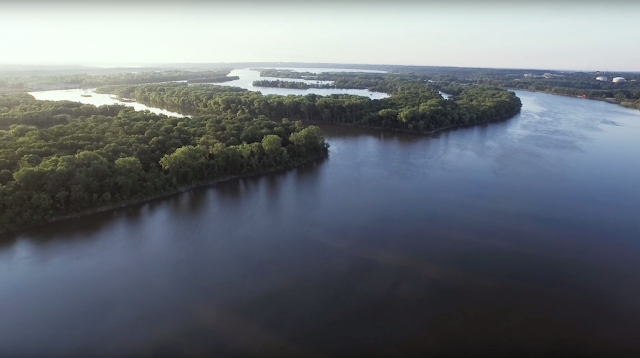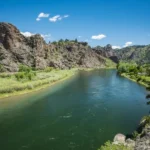
The Mississippi River is one of the world’s major river systems in size, habitat diversity and biological
productivity.
The Mississippi River flows through Minnesota, Wisconsin, Iowa, Illinois, Missouri, Kentucky, Tennessee, Arkansas, Mississippi, and Louisiana.
The Mississippi River lies entirely within the United States.
The Mississippi River’s main tributaries include the St. Croix River, Wisconsin Rover, Rock River, Illinois River, Kaskaskia River, Ohio River, Minnesota River, Des Moines River, Missouri River, White River, Arkansas River, and the Red River.
The Mississippi River flows from its source at Lake Itasca through the center of the continental United States to the Gulf of Mexico.
Major cities that the Mississippi Rover passes through include Minneapolis, St. Paul, La Crosse, Quad Cities, St. Louis, Memphis, Baton Rouge, and New Orleans.
The Mississippi River lies in the following 10 US states: Minnesota, Wisconsin, Iowa, Illinois, Missouri, Kentucky, Tennessee, Arkansas, Mississippi, and Louisiana.
A drop of rain that lands at the mouth of the Mississippi River will take 90 days to reach the basin.
The length of the Mississippi River is approximately 3,730 kilometers (2,320 miles), slightly shorter than the Missouri River.
There are more than 360 fish species, 325 bird species, 50 mammal species, and 145 amphibian species living in and around the Mississippi River. More than 25% of North America’s fish species can be found in the Mississippi River. The river corridor is extremely important to migratory birds as well.
Steamboats were used until approximately 1910, for transporting people and goods.
The Mississippi River’s deepest spot is located in New Orleans near Algiers Point. The river is approximately 200 feet deep there.
The Mississippi and Missouri Rivers combine to form the longest river system in the USA and North America. It is also the fourth longest in the world.
The first bridge built to cross the Mississippi River was constructed in 1855. The next year the first railroad bridge crossing the river was built.
At its widest point, the Mississippi River stretches out over 11 kilometers (7 miles) in width.
The average flow rate at the Mississippi River’s mouth is 6 cubic feet per second, while the average flow rate at the basin is 600,000 cubic feet per second.
The Mississippi River’s deepest spot is located in New Orleans near Algiers Point. The river is approximately 61 meters (200 feet) deep there.
In 2002 Martin Strel swam the entire length of the Mississippi River. It took him 68 days.
The Mississippi River discharges at an annual average rate of between 7,000–20,000 cubic meters per second (200,000 and 700,000 cubic feet per second). Although it is the 5th largest river in the world by volume the Mississippi has only 8% the flow of the Amazon River.
Life on the Mississippi is a book written by Mark Twain in reference to the steamboat era between 1830 and 1870. Most of Mark Twain’s work involved the Mississippi River in some way, either as the setting or part of the story.
It takes 90 days for one single drop of water to travel the entire length of the Mississippi River.
The elevation of the Mississippi at Lake Itasca is 450 meters (1,475 feet) above sea level. It drops to 0 meters above sea level at the Gulf of Mexico. More than half of that drop in elevation occurs within the state of Minnesota.
The Mississippi River can be divided into three sections: the Upper Mississippi, the river from its headwaters to the confluence with the Missouri River; the Middle Mississippi, which is downriver from the Missouri to the Ohio River; and the Lower Mississippi, which flows from the Ohio to the Gulf of Mexico.
The Mississippi River became the Spanish/British border in 1763 as per the Treaty of Paris.
The Mississippi River has the world’s fourth largest drainage basin. The basin covers more than 3,220,000 square kilometers (1,245,000 square miles), including all or parts of 31 U.S. states and two Canadian provinces.
The name Mississippi is derived from the Ojibwe word ‘misi-ziibi’ which means ‘great river’.
The Mississippi River’s main tributaries include the Missouri River, Ohio River, St. Croix River, Wisconsin Rover, Rock River, Illinois River, Kaskaskia River, Minnesota River, Des Moines River, White River, Arkansas River, and the Red River.
There are more than 260 fish species (25% of all fish species in North America), 325 bird species, 50 mammal species, and 145 amphibian species living in and around the Mississippi River.
In the 1600s Jacques Marquette and Louis Jolliet further explored the Mississippi River, guided by Ne Tongo, a Sioux Indian.
It is estimated that 18 million people or more than 50 cities rely on the Mississippi for their daily water supply.
The Great River Road, which runs alongside the river, was created in 1938. It is a collection of state and local roads which follow the course of the Mississippi River through ten states of the United States.
More than 170 bridges (automobile, foot and railroad) span the Mississippi River. The first bridge built across the Mississippi River was in 1855 with the first railroad bridge finished a year later in 1856.
Hernando de Soto named the river Rio del Espiritu Santo, which means ‘river of the Holy Spirit’.
Major cities that the Mississippi Rover passes through include Minneapolis, St. Paul, La Crosse, Quad Cities, St. Louis, Memphis, Baton Rouge, and New Orleans.
The Mississippi River got its name from the Ojibwe Indians who called the river Misi-ziibi, which meant “great river.”
Hernando de Soto, a Spanish explorer, was the first European to record reaching the Mississippi River. He arrived on May 8th, 1541.
The area of the Mississippi River basin was first settled by hunting and gathering Native American peoples and is considered one of the few independent centers of plant domestication in human history. Evidence of early cultivation of sunflower, a goosefoot, a marsh elder and an indigenous squash dates to the 4th millennium BCE.
On May 8, 1541, Spanish explorer Hernando de Soto became the first recorded European to reach the Mississippi River, which he called Río del Espíritu Santo (“River of the Holy Spirit”), in the area of what is now Mississippi.
The Mississippi River has had strong historical significance in the USA from Native American tribes through to European explorers, the American Civil War, the Great Mississippi Flood of 1927 and its modern commercial uses.
Many of Mark Twain’s famous stories are related to or take place near the Mississippi River, this includes his most famous work ‘Adventures of Huckleberry Finn’.
The sport of water skiing was invented in 1922 on the rive in a wide region between Minnesota and Wisconsin known as Lake Pepin.
Martin Strel, a Slovenian swimmer who is famous for swimming the length of entire rivers conquered the Mississippi over 68 days in 2002.









